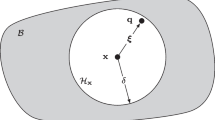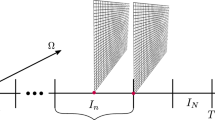Abstract
In this paper we describe, analyse and implement a parallel iterative method for the solution of the steady-state drift diffusion equations governing the behaviour of a semiconductor device in two space dimensions. The unknowns in our model are the electrostatic potential and the electron and hole quasi-Fermi potentials. Our discretisation consists of a finite element method with mass lumping for the electrostatic potential equation and a hybrid finite element with local current conservation properties for the continuity equations. A version of Gummel's decoupling algorithm which only requires the solution of positive definite symmetric linear systems is used to solve the resulting nonlinear equations. We show that this method has an overall rate of convergence which only degrades logarithmically as the mesh is refined. Indeed the (inner) nonlinear solves of the electrostatic potential equation converge quadratically, with a mesh independent asymptotic constant. We also describe an implementation on a MasPar MP-1 data parallel machine, where the required linear systems are solved by the preconditioned conjugate gradient method. Domain decomposition methods are used to parallelise the required matrix-vector multiplications and to build preconditioners for these very poorly-conditioned systems. Our preconditioned linear solves also have a rate of convergence which degrades logarithmically as the grid is refined relative to subdomain size, and their performance is resilient to the severe layers which arise in the coefficients of the underlying elliptic operators. Parallel experiments are given.
Zusammenfassung
Diese Arbeit enthält die Beschreibung, Analyse und Implementierung eines parallelen iterativen Verfahrens zur Lösung der stationären Drift-Diffusions-Gleichung für ein zweidimensionales Halbleitermodell. Die Unbekannten unseres Modells sind das elektrostatische Potential und die Quasi-Fermi-Potentiale der Elektronen und Löcher. Unsere Diskretisierung verwendet die Finite-Element-Methode mit ‘mass limping’ für das elektrostatische Potential und hybride Elemente mit lokaler Stromerhaltung für die Kontinuitätsgleichung. Zur Lösung der entsprechenden nichtlinearen Gleichungen wird eine Version des Gummel-Algorithmus verwendet, der lediglich die Lösung positiv definiter, symmetrischer linearer Gleichungssysteme erfordert. Wir zeigen, daß diese Methode eine Konvergenzrate besitzt, die nur logarithmisch von der Schrittweite abhängt. Die (inneren) nichtlinearen Löser der elektrostatischen Potentialgleichung konvergieren gitterunabhängig quadratisch. Wir beschreiben auch eine Implementierung auf einem MasPar MP-1-Parallelrechner, wobei die auftretenden linearen Systeme mit einem vorkonditionierten cg-Verfahren approximiert werden. Gebietszerlegungsmethoden werden eingesetzt, um die notwendige Matrix-Vektor-Multiplikation zu parallelisieren und Vorkonditionierer dieser schlechtkonditionierten Systeme zu erstellen. Die vorkonditionierten linearen Löser haben ebenfalls eine Konvergenzrate, die logarithmisch vom Verhältnis Teilgebietsgröße zu Schrittweite abhängt und welche robust ist bezüglich stark variierenden Koeffizientenfunktionen des zugrundeliegenden elliptischen Operators. Experimente auf einem Parallelrechner werden diskutiert.
Similar content being viewed by others
References
Babuska, I., Osborne, J. E.: Generalised finite element methods: their performance and their relation to mixed methods. SIAM. J. Numer. Anal.20, 510–536 (1983).
Bank, R. E.: PLTMG: A software package for solving elliptic partial differential equations. Philadelphia: SIAM 1990.
Bank, R. E., Coughran, W. M., Driscoll, M. A., Smith, R. K., Fichtner, W.: Iterative methods in semiconductor device simulation. Comput. Phys. Commun.53, 201–212 (1989).
Bank, R. E., Rose, D. J., Fichtner, W. F.: Numerical methods for semiconductor device simulation. SIAM J. Sci. Stat. Comp.4, 416–435 (1983).
Bjørstad, P. E., Widlund, O. B.: Iterative methods for the solution of elliptic problems on regions partitioned into substructures. SIAM J. Numer. Anal.23, 1097–1120 (1986).
Bramble, J. H., Pasciak, J. E., Schatz, A. H.: The construction of preconditioners for elliptic problems by substructuring. Math Comp.47, 103–134 (1986).
Brezzi, F., Marini, L. D., Pietra. P.: Numerical simulation of semiconductor devices. Comp. Meth. Appl. Mech. Eng.75, 493–514 (1989).
Ciarlet, P. G.: The finite element method for elliptic problems. Amsterdam: North-Holland 1978.
Coomer., R. K.: Parallel iterative methods in semiconductor device modelling. PhD thesis, School of Mathematical Sciences, University of Bath, 1994.
Coomer, R. K., Graham, I. G.: Domain decomposition methods for device modelling. In: Keyes, D. E., Xu, J. (eds.) Domain decomposition techniques in science and engineering. Providence American Mathematical Society, 1994.
De Zeeuw, P. M.: Nonlinear multigrid applied to a 1D stationary semiconductor model. SIAM J. Sci. Stat. Comp.13, 512–530 (1992).
Dryja, M., Widlund, O. B.: Some domain decomposition algorithms for elliptic problems. In: Hayes, L., Kincaid, D. (eds.) Iterative methods for large linear systems. Orlando: Academic Press 1989.
Dryja, M., Widlund, O. B.: Multilevel additive methods for elliptic finite element problems. In: Hackbusch, W. (ed.) Parallel algorithms for PDEs. Braunschweig: Vieweg 1991.
Gummel, H. K.: A self-consistent iterative scheme for one-dimensional steady state transistor calculations. IEEE Trans. Electronic Dev.ED-11, 455–465 (1964).
Jerome, J. W.: Consistency of semiconductor modeling: an existence/stability analysis for the stationary Van Roosbroeck system. SIAM. J. Appl. Math.45, 565–590 (1985).
Jerome, J. W., Kerkhoven, T.: A finite element approximation theory for the drift diffusion semiconductor model. SIAM J. Numer. Anal.28, 403–422 (1991).
Johnson, C.: Numerical solutions of partial differential equations by the finite element method. Cambridge: Cambridge University Press 1987.
Kerkhoven, T.: Coupled and decoupled algorithms for semiconductor simulation. PhD thesis, Department of Computer Science, Yale University, 1985 (Yale Research Report YALEU/DCS/RR-429).
Kerkhoven, T.: A proof of convergence of Gummel's algorithm for realistic device geometries. SIAM J. Numer. Anal.23, 1121–1136 (1986).
Kerkhoven, T.: On the effectiveness of Gummel's method. SIAM J. Sci. Stat. Comput.9, 48–60 (1988).
Mandel, J.: Hybrid domain decomposition with unstructured subdomains. Preprint, 1993.
Markowich, P. A.: The stationary semiconductor device equations. Wien-New York: Springer 1986.
Markowich, P. A., Ringhofer, C. A., Schmeiser, C.: Semiconductor equations. Wien-New York: Springer 1990.
Markowich, P. A., Zlámal, M. A.: Inverse-average-type finite element discretizations of selfadjoint second-order elliptic problems. Math. Comput.51, 431–449 (1988).
MasPar Computer corporation, Sunnyvale, California, 1990. MasPar system overview.
Ortega, J. M., Rheinboldt, W. C.: Iterative solution of nonlinear equations in several variables. New York: Academic Press 1970.
Patankar, S. V.: Numerical heat transfer and fluid flow. New York: McGraw-Hill 1980.
Polak, S. J., Den Heijer, C., Schilders, W. H. A., Markowich, P.: Semiconductor device modelling from the numerical point of view. Int. J. Numer. Meth. Eng.24, 763–838 (1987).
Potra, F. A.: Newton-like methods with monotone convergence for solving nonlinear operator equations. Nonlinear Anal. Theory Meth. Appl.11, 697–717 (1987).
Scharfetter, D. L., Gummel, H. K.: Large-signal analysis of a silicon Read diode oscillator. IEEE Trans. Electron Dev.ED-16, 64–77 (1991).
Smith, B. F.: A domain decomposition algorithm for elliptic problems in three dimensions. Numer. Math.60, 219–234 (1991).
Smith, B. F.: An optimal domain decomposition preconditioner for the finite element solution of linear elasticity problems. SIAM. J. Sci. Stat. Comput.13, 364–378 (1992).
Smith, B. F., Widlund, O. B.: A domain decomposition algorithm using a hierarchical basis. SIAM J. Sci. Stat. Comp.11, 1212–1220 (1990).
Wang, Z.-Y., Wu, K.-C., Dutton, R. W.: An approach to construct pre conditioning matrices for block iteration of linear equations. IEEE Trans. CAD11, 1334–1343 (1992).
Wu, K.-C., Lucas, Z.-Y., Dutton, R. W.: New approaches in a 3D one-carrier device solver. IEEE Trans. CAD8, 528–537 (1989).
Author information
Authors and Affiliations
Rights and permissions
About this article
Cite this article
Coomer, R.K., Graham, I.G. Massively parallel methods for semiconductor device modelling. Computing 56, 1–27 (1996). https://doi.org/10.1007/BF02238289
Received:
Revised:
Issue Date:
DOI: https://doi.org/10.1007/BF02238289




